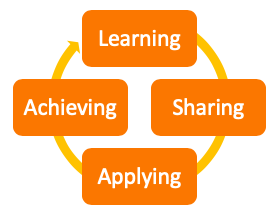In 2017, one of the guests on my Year of the Peer podcast (renamed What Anyone Can Do in 2018 and Peernovation in 2020) was Dr. Linda Darling-Hammond, professor emeritus at Stanford’s Graduate School of Education and CEO of the Learning Policy Institute. During our conversation, she told me the more that teachers collaborate with one another outside the classroom, the more effective they can be at building collaborative environments among students inside their classrooms. Countless leaders of CEO and key executive peer groups have said the same holds true in business. Essentially, leaders who do group work are more emotionally and intellectually fit to inspire superior teamwork inside their organizations. Let’s look at why.
To back up a moment, let’s distinguish between group and team. A group is one where people come together to help each other realize their individual goals. A team is a collection of people who collaborate in an effort to achieve a common goal. CEOs connect with other CEOs in groups because they believe that talking with peers who share their common challenges, yet who may come from very different worlds, will help them be better individual leaders and provide them with ideas and insights to help them grow their companies. College athletes, on the other hand, who participate in a team sport, may aspire to win a national championship – a single goal that can only be achieved as a high performing team.
Think of mastermind groups as the “practice fields” for team leaders. Groups are the perfect training ground for strengthening your leadership muscles, building your business acumen, and fine-tuning your emotional intelligence. My guess is that you wouldn’t consider entering the IRONMAN, running a marathon, or cycling the Tour de France without training for it; yet too many organizational leaders attempt something equally difficult every day they show up to work without having stepped one foot onto a practice field. You can argue that you can train in other ways. Fair point. You can read books, hire a coach, go to conferences, etc. That said, here’s one thing (among many) you won’t get anywhere else except in a group – it’s called the Learning-Achieving cycle.

The Learning-Achieving Cycle, The Power of Peers (2016)
Dr. Darling-Hammond told me that we learn better when we learn together. When we share our learning with one another and engage in deep conversation about a given concept, it not only helps us understand it more completely, but also provides group members the courage to ACT on that learning. You might read something in a book that on its face seems like a great idea, but you’re unlikely to walk into the office the next day and implement it. Within days, that idea joins the pile of other interesting things you learned that you never acted on. Once you act on your learning (trial and error notwithstanding) and you achieve positive results, it inspires you to want to learn more. This creates a reinforcing loop of learning, sharing, applying, achieving that becomes a force of nature of its own – a force fueled by a leader’s insatiable desire to leverage the group’s intellectual capital for his/her own personal and organizational ROI.

If you want to lead higher performing teams, find a place to practice – find yourself a mastermind group. That said, here’s my one disclaimer: Mastermind group membership is not for everyone. If you treat it as a spectator sport, you won’t do yourself or your fellow members any good. But if you dig deep, invest in yourself, and do the work, then you, your group members, and your organizational team(s) will be the big winners for it.
If you have a story about how your mastermind group helped you hone your skills as a more effective team leader, share it in the comments! Thanks!


2 thoughts on “Mastermind Groups: Practice Fields for Leaders (Updated 5/29/2020)”